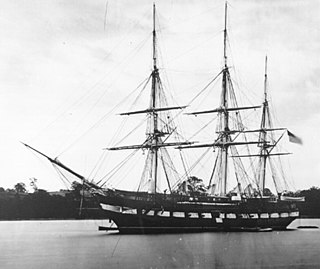Ten ships of the Royal Navy have been named HMS Hermes, after Hermes, the messenger god of Greek mythology, while another was planned:

HMS Hermes was a conventional British aircraft carrier and the last of the Centaur class.

In the 18th century and most of the 19th, a sloop-of-war in the Royal Navy was a warship with a single gun deck that carried up to eighteen guns. The rating system covered all vessels with 20 guns and above; thus, the term sloop-of-war encompassed all the unrated combat vessels, including the very small gun-brigs and cutters. In technical terms, even the more specialised bomb vessels and fireships were classed as sloops-of-war, and in practice these were employed in the sloop role when not carrying out their specialised functions.
The Royal Navy has used the name Comet no fewer than 18 times:
Ten ships of the Royal Navy have been named HMS Aetna or HMS Etna, after the volcano Etna:
Nine ships and one shore establishment of the Royal Navy have been named HMS Wasp, with one other government vessel using the name:

The Cruizer class was an 18-gun class of brig-sloops of the Royal Navy. Brig-sloops were the same as ship-sloops except for their rigging. A ship-sloop was rigged with three masts whereas a brig-sloop was rigged as a brig with only a fore mast and a main mast.
Nine ships of the Royal Navy have borne the name HMS Investigator. Another was planned, but renamed before being launched. The name Investigator passed on to the Royal Indian Navy and after India's Independence, to its successor the Indian Navy where the lineage of naming survey ships Investigator continues unbroken.

The Portuguese-class trawlers of World War II were naval trawlers, built in Portugal for the Royal Navy.
HMS Hermes was a 20-gun Hermes-class sixth-rate flush-decked sloop-of-war built in Milford Dockyard to the lines of the ex-French Bonne Citoyenne. She was destroyed in 1814 to prevent her falling into American hands after grounding during her unsuccessful attack on Fort Bowyer on Mobile Point outside Mobile, Alabama.
The Hermes class were a series of four 20-gun ships, launched between 1811 and 1816. Two pairs of ships were produced, to slightly different designs – the first two had 20 guns and were unrated flush-decked ship-sloops, whilst the latter two were converted to 26-gun sixth-rates. The design was based on the ex-French 20-gun corvette Bonne Citoyenne, which the British had captured in 1796.
Seven ships of the Royal Navy have borne the name HMS Strombolo, or HMS Stromboli, after the volcano Stromboli, in Italy:
Six ships of the Royal Navy have borne the name HMS Camel, after the camel:
HMS Spy was launched at 1800 at Topsham in 1800 as the mercantile vessel Comet. The Royal Navy purchased her in 1804 and renamed her HMS Spy. From 1810 she served as store ship. In 1812 she repelled an attack by a French privateer in a single-ship action. The French captured her in 1812 and then released her. The Navy sold her in 1813. Her new owners returned her to mercantile service under the name Comet. She was last listed in 1829.
Several vessels have been named Recovery:
Several ships have been named Majestic:
Several vessels have been named Salamander for the Salamander:
Several vessels have been named Leander for one the protagonists in the story of Hero and Leander in Greek mythology.
Several vessels have been named Lynx for the lynx:
This page is based on this
Wikipedia article Text is available under the
CC BY-SA 4.0 license; additional terms may apply.
Images, videos and audio are available under their respective licenses.



